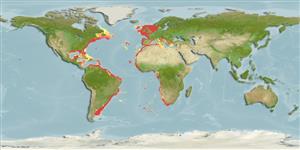Preferred temperature (Ref.
123201): 7.3 - 27.5, mean 13.9 °C (based on 3020 cells).
Phylogenetic diversity index (Ref.
82804): PD
50 = 0.5001 [Uniqueness, from 0.5 = low to 2.0 = high].
Bayesian length-weight: a=0.01380 (0.01026 - 0.01858), b=2.99 (2.91 - 3.07), in cm total length, based on LWR estimates for this species (Ref.
93245).
Niveau trophique (Ref.
69278): 4.5 ±0.6 se; based on diet studies.
Résilience (Ref.
120179): Faible, temps minimum de doublement de population : 4,5 à 14 années (Fec=60;).
Fishing Vulnerability (Ref.
59153): Very high vulnerability (90 of 100).
Nutrients (Ref.
124155): Calcium = 4.55 [0.56, 83.64] mg/100g; Iron = 0.469 [0.043, 5.703] mg/100g; Protein = 16.5 [12.3, 20.1] %; Omega3 = 0.287 [0.104, 0.796] g/100g; Selenium = 43.8 [7.7, 218.9] μg/100g; VitaminA = 10.9 [0.8, 145.9] μg/100g; Zinc = 0.386 [0.021, 4.499] mg/100g (wet weight);
